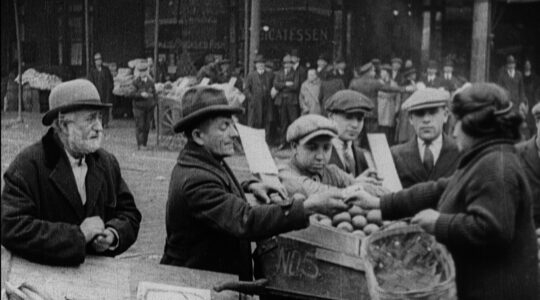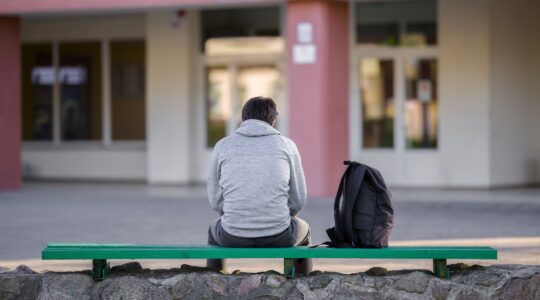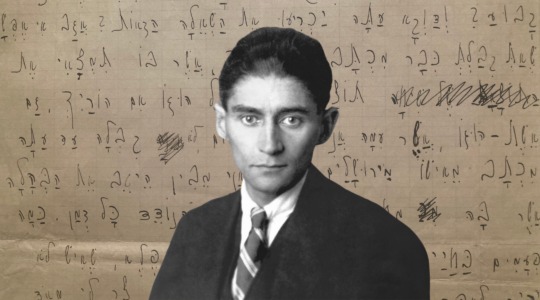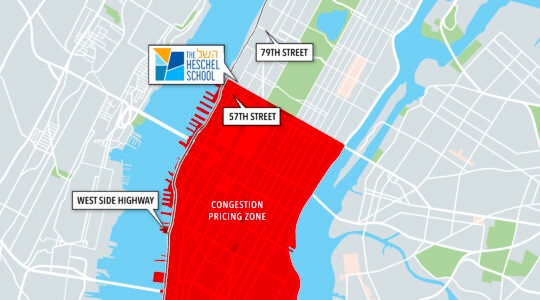The road that the “child of God” was walking on was Route 17, the “Mother Road” of the Jewish mountains. To get to Woodstock you took 17 to 17B, west out of Monticello, with a right turn, just past the lake, on Hurd Road into Yasgur’s alfalfa fields. It was Aug. 15-18, 1969.
I was in Camp Hi-Li that summer, an Orthodox camp about a 20-minute walk away, around the banks of White Lake. One could hear Janis Joplin through the clouds in the night.
The day or so before, hitching back to camp from Monticello, I was given a ride in a van with an eight-track in the glove compartment playing the first Crosby, Stills & Nash album.
On camp trips, counselors noticed billboards on Catskills roads advertising “Three Days of Peace and Music,” with what was to become the famous logo of a white dove perched on a guitar neck.
There was a kid in camp who had a bar mitzvah scheduled that Shabbos; some of his guests were stuck on Route 17 with tens of thousands of musical pilgrims, many of whom parked their cars on either side of the road and walked. It was reported that some of the musicians heading to Woodstock, including Melanie (she of “Beautiful People,” driving in her 1968 Pontiac Bonneville with her mother), were stuck, as well, and got rooms in local hotels, awaiting a helicopter shuttle.
Woodstock Nation didn’t know Route 17 was always like that on Friday afternoons.
By that Friday afternoon, according to the local Times Herald-Record, food was being airlifted from Newburgh’s Stewart Air Force base, and the folks over at the Monticello Jewish Community Center were making sandwiches “with 200 loaves of bread, 40 pounds of cold cuts and two gallons of pickles,” hardly enough.
A nurse with antibiotics helicoptered to the festival from Grossinger’s hotel. In what was still the Catskills’ Jewish heyday, the festival and its celebrants spilled over into the nearby roads and towns. Friday night, the music coming out of the clouds was, you might say, somewhat Shabbosdik: Incredible String Band, Tim Hardin, Joan Baez. On Shabbos afternoon, as not only “a child of God” but God’s other children, the bungalow Jews, went walking along the road, the music in the air turned raucous: Santana, Mountain, Canned Heat. The country Jews understood “Canned Heat” and their “Goin’ Up The Country.” The “country,” to us, meant the Catskills, “gotta leave the city, got to get away.”
The distant music from across the lake and hills mixed across Sullivan County with the niggunim, the gentle melodies of a twilight shalashudos, the spare meal ushering out a summer’s Shabbos.
It wasn’t really the Catskills’ heyday; too many hotels were beginning to fray around the edges. And that’s how the festival came to White Lake. Elliot Tiber, manager of the El Monaco Hotel (don’t let the name fool you, it was a Jewish hotel, like the nearby El Dorado) had empty rooms. His Jewish clientele increasingly preferred vacations that required a plane.
When Tiber heard that the town elders of Wallkill, N.Y. — the original site of the festival — were resisting the idea of giving a festival permit to outside agitators who’d overtake their town (this was just one summer after the 1968 riots that wreaked havoc from Columbia University to the Democratic Convention in Chicago), Tiber dialed up the Woodstock organizers.
Tiber, you see, had a permit. It was an official Bethel, N.Y., town permit, costing less than $20, allowing him to put on shows. In the spirit of Catskills inflation, where a simple grapefruit can be called a “Chilled Grapefruit Supreme,” and a ventriloquist twirling plates can be advertised as a “Broadway Show,” Tiber’s permit allowed him to put on a “White Lake Music and Arts Festival,” something he dreamed up to jack up business. He hadn’t anything in mind, at first, just something staid for his usual “crowd.”
He told the Woodstock organizers that he had plenty of hotel rooms. And he had a buddy, Max Yasgur, who delivered El Monaco’s milk and cheese. Yasgur had the biggest dairy farm in Sullivan County, but maybe they could use his alfalfa field, just across the road.
On the second night of Woodstock, after Shabbos, I, all of 17 years, rather than going to the camp’s canteen, walked a dark gravelly road in search of this Oz that landed on my Kansas.
It was a smoky, hazy, tie-dyed night, VW buses and abandoned cars on either side of the road, everyone talking to strangers, as I was carried on a wave into someone’s dimly lit living room, crowded with strangers. I was a stranger, too.
For several years, all that remained was a stone slab with a metal plaque marking the spot on Hurd Road, the plaque naming all the musicians who performed on that 1969 weekend.
In 1984, on the 15th anniversary, Grossinger’s, in its dying years, tried to have a Woodstock weekend — but not many guests cared. The hotel had invited media coverage, and I was one of maybe three writers who covered what little there was to cover. Abbie Hoffman, thrown off the Woodstock stage for making a political speech by The Who’s Pete Townsend — who whacked Hoffman in the head with a guitar — was brought in by Grossinger’s.
Recognized by few, Hoffman enjoyed the idea of eating in the main dining room. He was a Catskills comedian at heart, and he’d become more Jewish in middle age. Not long before, he happily posed for a subscription ad for New Jewish Times, a paper I was working on.
The ad copy, in those Soviet Jewry years, had Hoffman holding up the paper, saying: “She’s no refusenik when I ask her.” He sat in the hotel lobby, telling stories, but everyone did that in the lobby.
Leaving Grossinger’s I drove to White Lake, but the old summer camp was in ruins, sheets of papers and color war placards strewn about in the old dining room. I drove to Hurd Road, to the shady area where the stone marked the spot. The field was every bit as overgrown and empty as the abandoned hotel lawns down the road.
Then, in the quiet, with almost no one around other than Hoffman and a ragged pilgrim or two, John Sebastian drove by, alone in his car, from his home in the Hudson Valley. He, who played there, wanted to see the old hillside. There was small talk in the shade. No one really said much; it seemed too long ago and lost.
If you’re lucky, after paradise gives way to a parking lot, the parking lot gives way to a museum. Admission can be charged for stories once told in hotel tearooms. On Hurd Road there is now the sparkling sylvan-themed Bethel Woods Center for the Arts, combining a museum of the Woodstock festival and a summer music stage. In the museum, which opened in June, is a yellow school bus, painted psychedelically, like Ken Kesey’s lived-in bus with its destination sign, “Further,” that transported Kesey’s Merry Pranksters from Oregon to White Lake in 1969.
Sitting in the bus, one watches the windshield — a movie screen, really — showing the unfolding roads of Route 17, turning to 17B, and up Hurd Road, where children of God once walked, and walk still.
Last week, the Allman Brothers and Bob Weir, who played Woodstock with the Grateful Dead, played at Bethel Woods. The Jonas Brothers also played there last week, which only goes to show you something or other.
Joe Cocker came back this summer, even Melanie.
Like a grownup going on Facebook, the New York Philharmonic played the old Woodstock site, too, performing a surreal symphonic version of Jimi Hendrix’s already surreal “Star Spangled Banner,” giving proof through the night that our flag was still there.
The New York Jewish Week brings you the stories behind the headlines, keeping you connected to Jewish life in New York. Help sustain the reporting you trust by donating today.




